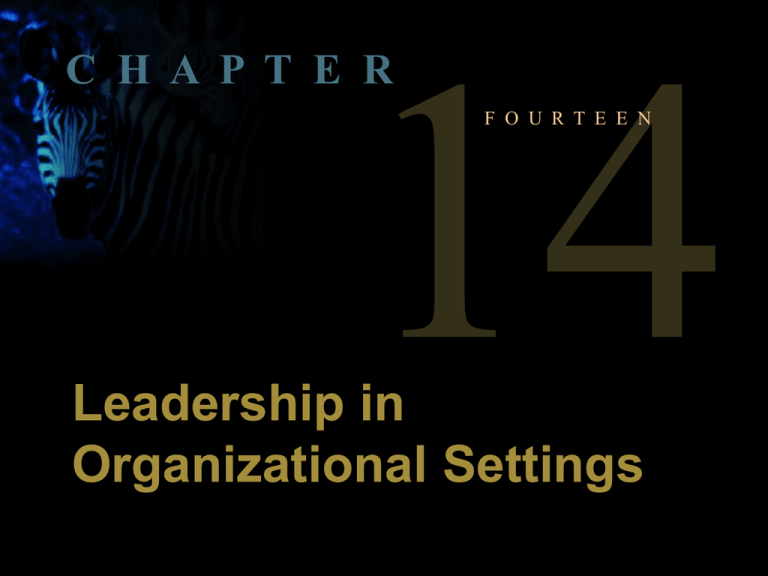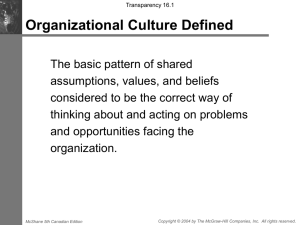
C H A P T E R
F O U R T E E N
.
Leadership in
Organizational Settings
McShane 5th Canadian Edition
1
Copyright © 2004 by The McGraw-Hill Companies, Inc. All rights reserved.
Emerging View of Leadership
“A great leader is one who
has vision, perseverance and
the capacity to inspire others,”
says Cynthia Trudell, the
Canadian executive who is
president of Brunswick
Corp.’s Sea Ray Group
CP/Nina Long
McShane 5th Canadian Edition
2
Copyright © 2004 by The McGraw-Hill Companies, Inc. All rights reserved.
What is Leadership?
Leadership is the ability
to influence, motivate,
and enable others to
contribute toward the
effectiveness of the
organizations of which
they are members
CP/Nina Long
McShane 5th Canadian Edition
3
Copyright © 2004 by The McGraw-Hill Companies, Inc. All rights reserved.
Perspectives of Leadership
Competency
Perspective
Implicit
Leadership
Perspective
Leadership
Perspectives
Transformational
Perspective
McShane 5th Canadian Edition
Behaviour
Perspective
Contingency
Perspective
4
Copyright © 2004 by The McGraw-Hill Companies, Inc. All rights reserved.
Seven Leadership Competencies
Emotional
Intelligence
Integrity
Drive
Leadership
Motivation
• Perceiving, assimilating, understanding,
and regulating emotions
• Truthfulness
• Translates words into deeds
• Inner motivation to pursue goals
• Need for achievement, quest to learn
• High need for socialized power to
accomplish team’s or firm’s goals
more
McShane 5th Canadian Edition
5
Copyright © 2004 by The McGraw-Hill Companies, Inc. All rights reserved.
Seven Leadership Competencies
Self-Confidence
(con’t)
• High self-efficacy regariing ability to lead
others
Intelligence
• Above average cognitive ability
• Can analyze problems/opportunities
Knowledge of
the Business
• Familiar with business environment
• Aids intuitive decision making
McShane 5th Canadian Edition
6
Copyright © 2004 by The McGraw-Hill Companies, Inc. All rights reserved.
Competency Perspective Limitations
• Leadership potential, not performance
– Still need to develop leader skills from these
competencies
• Implies a universal approach
– But some competencies might not be
valuable in all situations
• Some traits are subjective
– Supports implicit leadership theory
McShane 5th Canadian Edition
7
Copyright © 2004 by The McGraw-Hill Companies, Inc. All rights reserved.
Leader Behavioural Perspective
• People-oriented behaviours
– Showing mutual trust and respect
– Concern for employee needs
– Desire to look out for employee welfare
• Task-oriented behaviours
– Assign specific tasks
– Ensure employees follow rules
– Set “stretch goals” to achieve performance capacity
McShane 5th Canadian Edition
8
Copyright © 2004 by The McGraw-Hill Companies, Inc. All rights reserved.
Path-Goal Leadership Styles
• Directive
– Task-oriented behaviours
• Supportive
– People-oriented behaviours
• Participative
– Encouraging employee involvement
• Achievement-oriented
– Using goal setting and positive selffulfilling prophecy
McShane 5th Canadian Edition
9
Copyright © 2004 by The McGraw-Hill Companies, Inc. All rights reserved.
Path-Goal Leadership Model
Employee
Contingencies
Leader
Behaviours
•
•
•
•
Leader
Effectiveness
• Employee
motivation
• Employee
satisfaction
• Leader
acceptance
Directive
Supportive
Participative
Achievementoriented
Environmental
Contingencies
McShane 5th Canadian Edition
10
Copyright © 2004 by The McGraw-Hill Companies, Inc. All rights reserved.
Path-Goal Contingencies
Employee
Contingencies
Directive Supportive Participative Achievement
Skill/Experience
low
low
high
high
Locus of Control
external
external
internal
internal
Environmental
Contingencies
Directive Supportive Participative Achievement
Task Structure
nonroutine
routine
nonroutine
?
Team Dynamics
–ve norms
low cohesion
+ve norms
?
McShane 5th Canadian Edition
11
Copyright © 2004 by The McGraw-Hill Companies, Inc. All rights reserved.
Other Contingency Leadership Theories
• Situational Leadership Model
(Hersey/Blanchard)
– Effective leaders vary style with follower “readiness”
– Leader styles – telling, selling, participating, and
delegating
• Fiedler’s Contingency Model
– Leadership style is stable --based on personality
– Best style depends on situational control -- leadermember relations, task structure, position power
McShane 5th Canadian Edition
12
Copyright © 2004 by The McGraw-Hill Companies, Inc. All rights reserved.
Leader Substitutes at Pursue Assoc.
Fortunato Restagno (front) and
his associates use leadership
substitutes more than direct
leadership to get their work
done. These substitutes likely
include common values,
rewards, training, and guidance
from coworkers.
Kitchener-Waterloo Record
McShane 5th Canadian Edition
13
Copyright © 2004 by The McGraw-Hill Companies, Inc. All rights reserved.
Leadership Substitutes
Contingencies that limit a leader’s
influence or make a particular
leadership style unnecessary.
Examples:
– Training and experience replace
task-oriented leadership
– Cohesive team replaces supportive
leadership
– Self-leadership replaces
achievement-oriented leadership
Kitchener-Waterloo Record
McShane 5th Canadian Edition
14
Copyright © 2004 by The McGraw-Hill Companies, Inc. All rights reserved.
Transformational Leadership at Suncor
Rick George, CEO, is a
transformational leader.
Through his vision and
actions, he transformed
Suncor Energy into one of the
leaders in Canada’s oil
industry.
Courtesy of Suncor Energy Inc.
McShane 5th Canadian Edition
15
Copyright © 2004 by The McGraw-Hill Companies, Inc. All rights reserved.
Transformational v. Transactional Leaders
Transformational leaders
– Leading -- changing the
organization to fit environment
– Change agents
Transactional leaders
– Managing -- linking job
performance to rewards
– Ensure employees have
necessary resources
– Apply contingency leadership
Courtesy of Suncor Energy Inc.
McShane 5th Canadian Edition
16
Copyright © 2004 by The McGraw-Hill Companies, Inc. All rights reserved.
Transformational Leadership Elements
Creating
a Strategic
Vision
Communicating
the Vision
Transformational
Leadership
Building
Commitment
McShane 5th Canadian Edition
Modelling
the Vision
17
Copyright © 2004 by The McGraw-Hill Companies, Inc. All rights reserved.
Implicit Leadership Perspective
Attributing
Leadership
Implicit
Leadership
Perspective
Need for
Situational
Control
McShane 5th Canadian Edition
Stereotyping
Leadership
18
Copyright © 2004 by The McGraw-Hill Companies, Inc. All rights reserved.
Cultural Issues in Leadership
• Societal cultural values and practices affect
leaders:
– Shape the leader’s values and norms
– Influence decisions and actions
• Some features of leadership are universal,
others differ across cultures
– “Charismatic visionary” seems to be universal
– Participative leadership works better in some
cultures than others
McShane 5th Canadian Edition
19
Copyright © 2004 by The McGraw-Hill Companies, Inc. All rights reserved.
Gender Issues in Leadership
• Male and female leaders have
similar task- and people-oriented
leadership.
• Participative leadership style is
used more often by female
leaders.
McShane 5th Canadian Edition
20
Copyright © 2004 by The McGraw-Hill Companies, Inc. All rights reserved.
Evaluating Female Leaders
• Past evidence
– women rated less favourably than equivalent
male leaders due to stereotyping
• Recent evidence
– women rated more favourably than men,
particularly on emerging leadership styles
(coaching, teamwork)
McShane 5th Canadian Edition
21
Copyright © 2004 by The McGraw-Hill Companies, Inc. All rights reserved.
C H A P T E R
F O U R T E E N
.
Leadership in
Organizational Settings
McShane 5th Canadian Edition
22
Copyright © 2004 by The McGraw-Hill Companies, Inc. All rights reserved.






